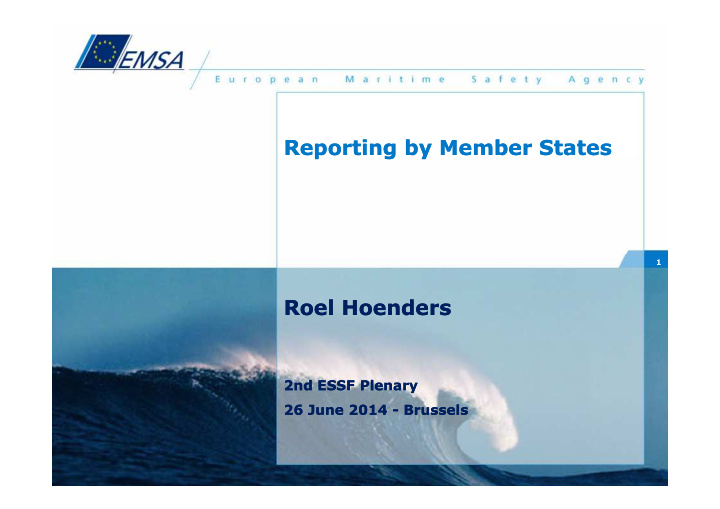



Reporting by Member States Reporting by Member States 1 Roel Hoenders Roel Hoenders 2nd ESSF 2nd ESSF Plenary Plenary 26 June 2014 26 June 2014 - - Brussels Brussels
Directive 2012/33 – amending Sulphur Directive Recital 18: � ‘Reporting by Member States has proved insufficient for the purpose of verification of compliance with the Directive due to the lack of harmonized and sufficiently precise provisions on the content and the format of the Member States’ reports.’ States’ reports.’ 2 2012 Reporting: � The EMSA analysis of the annual reporting by Member States (based on Directive 2005/33) confirms : General lack of homogeneity in the reporting system • Incomplete reports and vague data • Limited enforcement of specific Sulphur Directive • provisions Limited information about level of infringements •
Directive 2005/33/EC vs. Directive 2012/33/EU Directive 2005/32/EC Directive 2012/33/EU Art. 7 Reporting and Review Art 7 Reporting and Review: On the basis of the results of the sampling, 1. Each year by 30 June, Member States analysis and inspections carried out in shall, on the basis of the results of the accordance with Art. 6, Member States shall sampling, analysis and inspections by by 30 30 June June of of each each year year provide provide the the carried out in accordance with Art. 6, carried out in accordance with Art. 6, 3 Commission with a short report on the submit a report to the Commission on the sulphur content of the liquid fuels falling compliance with the sulphur standards within the scope of this Directive and used set out in this Directive for the within their territory during the preceding proceeding year. calendar year. 2. The Commission may adopt That report shall include a record of the total implementing acts concerning the number of samples tested by fuel type , information to be included in the and shall indicate the corresponding quantity report and the format of the report. of fuel used, and the calculated average sulphur content . Member States shall also report the number of inspections made on board ships.
Reporting: conclusions Overall, � Too little information available for the Commission to properly assess the level of compliance and enforcement of the Directive in Member States 4 � Enforcement efforts do not seem to be equally spread among Member States � In view of possible financial gains and to ensure a balanced level-playing-field under the revised Directive, the reporting by Member States will have to more accurate and detailed.
Reporting: contents and format EMSA questionnaire for Member States (Oct. 2013): Question 44 - Do you consider that European guidance aiming at uniform application of the provisions on reporting for the EU would be desirable? 20 20 17 17 5 15 10 YES 5 2 NO 0 Initial discussions about draft content of the report: � EMSA workshop for Member States (Oct. 2013) � Implementation Sub-Group meetings � EMSA training on air quality (Apr. 2014)
Reporting: contents and format Preliminary findings: � Despite importance of reporting for a proper verification of compliance, the Implementing Act on Reporting is largely dependent on the outcome of on-going discussions regarding ‘frequency of sampling’ and ‘sampling methods’ regarding ‘frequency of sampling’ and ‘sampling methods’ 6 � Exact scope of the requested information needs to be clear to avoid different interpretation of terminology/definitions � A balance needs to established between providing sufficient information to the Commission to assess level of compliance while avoiding making reporting too burdensome � Electronic ways of (automated) reporting should be accommodated
Reporting: contents and format Preliminary findings: � Member States and sub-group members have stressed the importance of assessing whether to include the following elements in the annual reporting: � More information on intensity of inspections of log books 7 + bunker delivery notes as first level of control � Information on quality of bunkers linked to suppliers � Specific enforcement of Sulphur Directive provisions: ships at berth, passenger ships, continuously achieving � Identification of the location from where the sample was taken � Better insights on number and level of infringement/irregularities
Reporting: contents and format Cont.: � More detailed information regarding penalties � Notifications of non-availability/letters of protest � The use of additional enforcement methods such as sniffing/remote sniffing/remote sensing sensing technologies, technologies, continuous continuous 8 monitoring equipment � Checks of alternative emission abatement methods (and possible malfunctioning) � Active link to day-to-day inspection results � …
Recommendations to the Plenary � Encourage the continuation of the discussions within the sub-group about the appropriate content and format of the reporting by Member States � Recognize that the contents of the Implementing Act on reporting reporting should should be be closely closely aligned aligned with with the the other other 9 developments related to enforcement (including penalties), and notably the Implementing Act concerning the frequency of sampling � Agree that a harmonized approach to reporting would be beneficial and than an electronic format would make it more efficient and less burdensome for both Member States and the Commission.
Recommend
More recommend